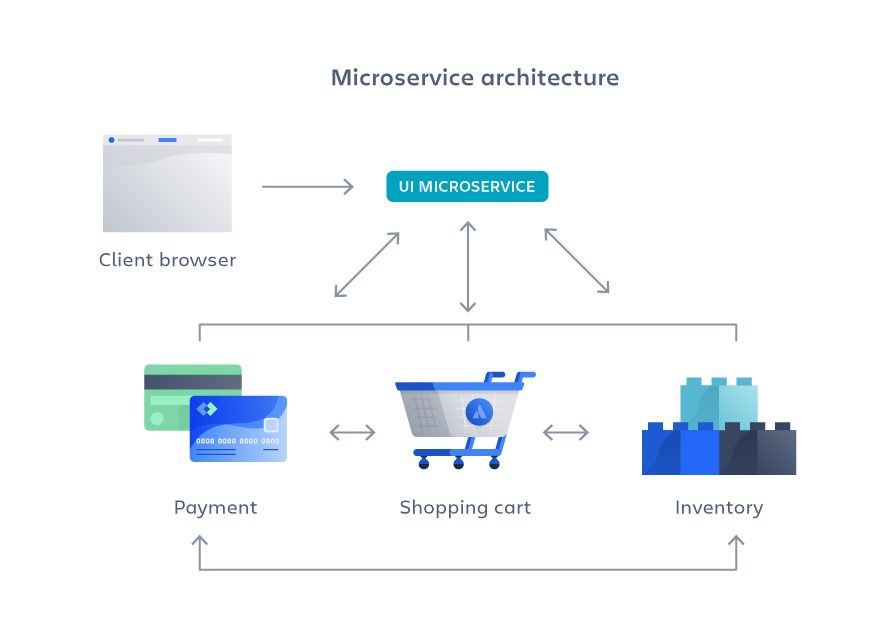In software development, Architecture refers to the underlying structure of programs. Two commonly used design patterns are monolithic and microservice architecture.The Monolith is simple and easy to implement for small to medium-sized applications, while microservice architecture breaks down an application into independent services that communicate through APIs.This blog will examine the distinctions between Monolith and microservices architecture, examining their advantages and disadvantages. By doing so, you’ll gain insights to make an informed decision on the ideal architecture for your project.
What is a Monolithic Architecture?
[Source: https://bit.ly/43pyoba ]
A monolithic application, often known as a “monolith,” is composed of a single large codebase that contains all of the application components, such as frontend code, backend code, and configuration files.
Monoliths are frequently regarded as an older and more traditional way of developing applications, but in truth, many firms profit from a monolithic architecture. They are frequently faster to design and deploy than microservice-based applications and may be easier to manage.
Once the application grows in complexity, monolithic applications can need more scalability and the challenges of maintaining a single codebase.
What are the Advantages of Monolithic Architecture?
- Simplicity in development and Deployment: All the components are centralized. It will be simple to develop and deploy, resulting in a faster time to market. Creating a monolith allows single developers or small development teams to create, test, and launch apps more quickly.
- Ease of Debugging: You can simply detect an issue by following the path of a request. This helps you to understand the user experience.
- Testing Easier: You simply test one service with no dependencies. Usually, everything is extremely clear because there is only one code repository to keep track of when testing and debugging, monoliths are often easier to test than microservices-based applications.
- Minimal expertise required: Most development teams can create a monolithic application today, whereas creating a microservices-based application requires specialized skills and training. The source code is only found in one location. New team members can quickly debug some functional flow and become acquainted with the application.
What are the Disadvantages of Monolithic Applications?
- Slower Development speed: A large, monolithic application makes development more complex and slower.
- Complex maintenance: A monolithic architecture can become more difficult to maintain and update as an application expands in size and complexity, resulting in longer development cycles and higher expenses.
- Limitation of scalability: Because all components are in one place and cannot be easily scaled independently, monolithic architectures may have scalability limitations.
- Higher code coupling: Although it is possible to have a separate service structure within your repository, over time, it’s common to have scattered and disorganized code, resulting in a more complex and difficult-to-understand system, especially for new team members.
What is a Microservices Architecture?
[Source: https://bit.ly/43pyoba ]
In today’s fast-paced world of software development, having a flexible and agile approach to designing apps is more crucial than ever. The microservice architecture allows developers to work more efficiently and release changes more quickly by breaking down an application into smaller and independent services that communicate with each other via APIs.
What are the Advantages of Microservice Architecture?
- Decentralized development and deployment: It provides the benefit of individual service deployment. This enables faster development, smoother bug fixes, and seamless feature releases. Unlike traditional applications, where a bug in one component can halt the entire release process, microservices allow for independent deployment, ensuring efficient development workflows.
- Minimalistic Codebase: In a microservices architecture, each service has its codebase or database, which minimizes dependencies and makes it easier to add new features. Additionally, having separate codebases simplifies understanding the code and adding new features.
- Scalability: With a microservices architecture, breaking down the application into smaller services makes it easier to scale each service independently without the need to scale the entire application.
- Versatility in technology selection: Microservices architecture allows for the use of different technologies for each service, providing flexibility and freedom in technology selection. With microservices, engineering teams are not limited to the technology chosen at the beginning, unlike monolithic architecture.
What are the Disadvantages of Microservices Architecture?
- Extra Complexity & Testing: Microservices simplify individual services but increase overall complexity by requiring the management of multiple services and databases, as well as independent deployment. Writing small services that rely on dependencies demands a different approach, and testing can become more complex, requiring mock services for unit testing.
- Connection Delay & Decentralized System: In a microservices architecture, the numerous small services require frequent inter-service communication, which can lead to latency issues if there is a long chain of dependencies. To avoid this problem, careful design of APIs is crucial. The system’s complexity, with its various modules and databases, also demands caution in managing all connections.
- Costly and Required Specialized Skill: Adopting microservices can save costs but requires extra development resources to manage each microservice and its dependencies. It demands specific expertise that not all developers possess, and lacking the training can cause challenges, delays, and additional expenses.
Thoroughly analyze the project’s requirements and resources to make an informed decision that aligns with the application’s goals and needs.
Summing Up
There are experts in the industry that will help you choose the right architecture for your software application according to the project requirement. Monolithic and microservices architectures are popular software application options, each with pros and cons.
Monolithic architecture offers simplicity in development and deployment, while microservices architecture brings decentralized development and deployment.
Always consider factors such as application size, complexity, team expertise, scalability needs, and time-to-market when choosing an architecture. Smaller applications with simple needs may benefit from a monolith, while larger and more complex applications may require the flexibility and scalability of microservices.
You can easily connect with us so that we can guide you in selecting the best solution for your project. Our team will consider your needs and goals to recommend the most suitable technology and architecture.






